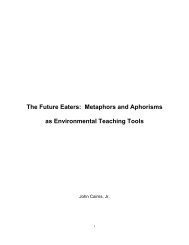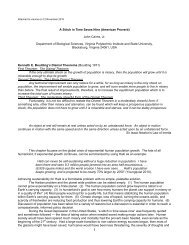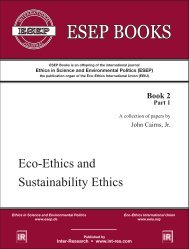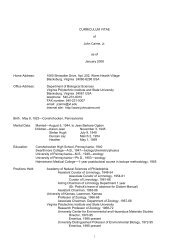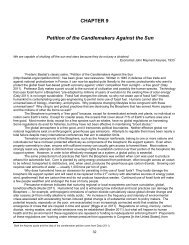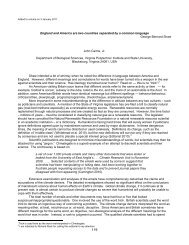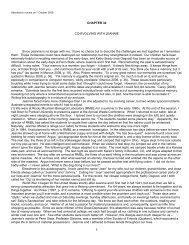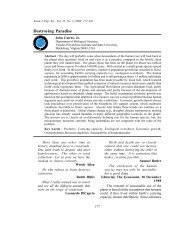View - ResearchGate
View - ResearchGate
View - ResearchGate
You also want an ePaper? Increase the reach of your titles
YUMPU automatically turns print PDFs into web optimized ePapers that Google loves.
Article 26223carrying capacities and, thus, also for lengthening the span the human species can persist. Onlythrough a development and application of eco-ethics can a catastrophe of gigantic dimensions beavoided (Kinne, 2001). The goal is to maintain Earth as a suitable habitat for humankind for manygenerations. However, this suitable habitat requires treating the interdependent web of life as inviolateand acknowledging humankind’s dependence upon it.WHY WORRY? WE HAVE PLENTY OF TIMESince most people think linearly rather than exponentially, any type of exponential growthcatches them unawares. A two percent growth rate seems harmless, but the resulting doublingtime is 35 years. For a town, this growth means doubling housing, schools, utilities, police and fireprotection, and roads every 35 years. Policy makers rarely plan for exponential growth in mostareas of life, but are obsessed with it for the stock market, corporate earnings, and increased sizeof towns, cities, church congregations, and the like. The importance of exponential growth is thatit causes populations to exceed carrying capacity through both size and increased depletion ofresources. Nature levies brutal penalties for exceeding carrying capacity, such as famine, disease,and war. Regrettably, people are not alarmed by exponential growth because those with short-termmemories regard present circumstances as normal. For example, the rate of human populationincrease is regarded as normal although, in terms of geologic or evolutionary time, it is aberrant.The global extinction of species crisis is well known. But as Myers and Knoll (2001) note, probablymore significant in the long term is that the crisis will disrupt and deplete certain processes ofevolution, with consequences likely to persist for millions of years. This biotic crisis is the result ofhuman activities that will be difficult to change. Tilman and Lehman (2001) believe that humancausedenvironmental changes are creating regional combinations of environmental conditionsthat, within the next 50 to 100 years, may fall outside of the envelope within which many of theterrestrial plants of a region evolved. Although mass extinctions probably account for the disappearanceof less than five percent of all extinct species, the evolutionary opportunities they havecreated have had a disproportionate effect on the history of life (Erwin, 2001). Mass extinctionsappear to cause a collapse of ecospace, which must be rebuilt during recovery (Erwin, 2001). Adelay of about five million years has long been apparent in the Early Triassic, after the end of thePermian mass extinction (Erwin, 2001).Invasive species are also a major factor in environmental disequilibrium. Elton (1958) was one ofthe pioneers to state that one of the great historical convulsions in the world’s fauna and flora isoccurring. This event is the result of a drastic breaching of biogeographic barriers that previouslyhad isolated the continental biotas for millions of years (Mooney and Cleland, 2001). Invasive speciesalter the evolutionary pathway of native species by competitive exclusion, niche displacement,hybridization, introgression, predation, and ultimately extinction (Mooney and Cleland, 2001).These authors conclude that the biota of Earth is undergoing a dramatic transformation, and everyindication is that these transformations will intensify as the human population continues to growbecause of the global changes that have been set in motion that are affecting the atmosphere andthe climate. Western (2001) remarks that ecosystem simplification is the ecological hallmark ofhumanity and the reason for humankind’s evolutionary success. However, the side effects ofhuman profligacy and poor resource practices are now so pervasive as to threaten the future, noless than that of biological diversity itself.The changes just briefly described are consistent with mainstream ecological science. The conclusionsare almost more than the mind can accept and far beyond the primary issues of the Kyoto



